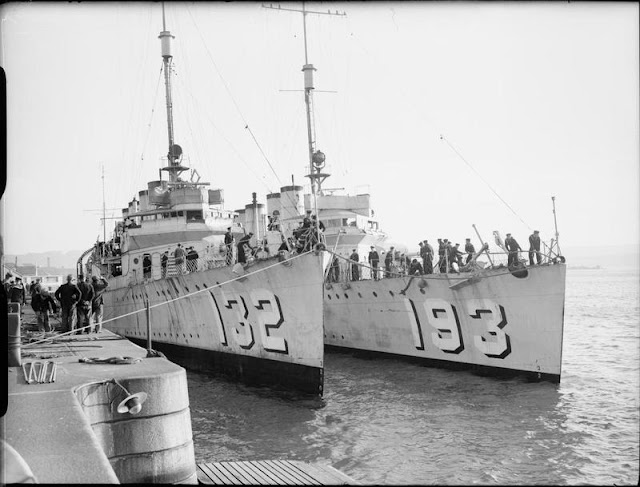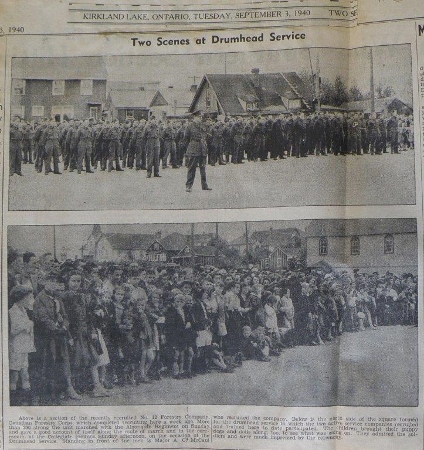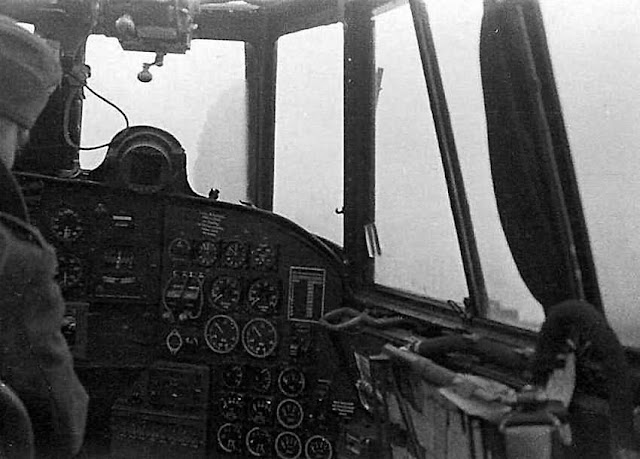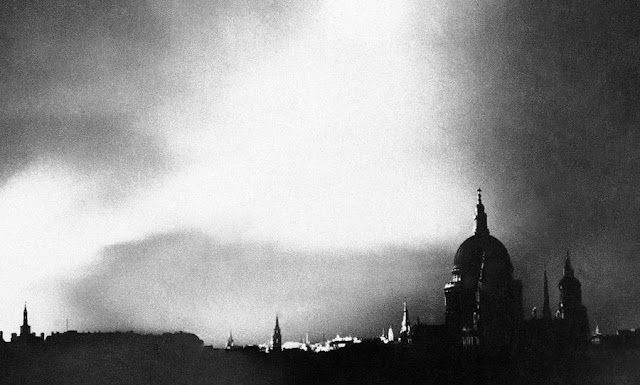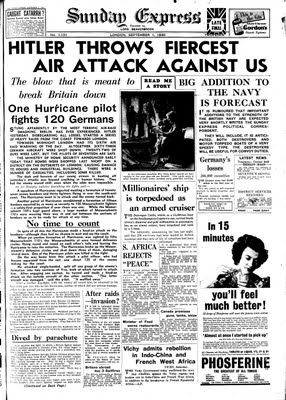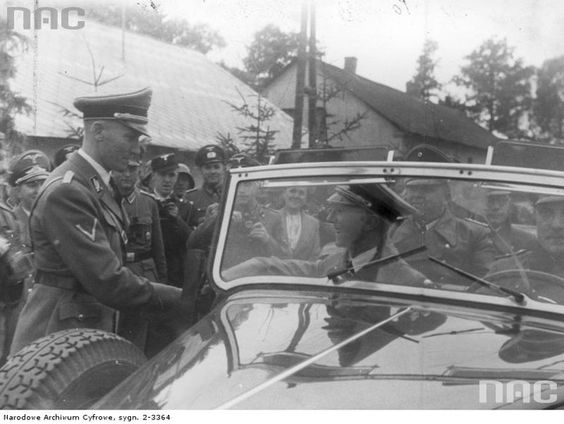Wednesday 4 September 1940
 |
| Adolf Hitler at the Sportpalast in Berlin, 4 September 1940. |
At one point, he addresses the question of when he intends to invade England, which is on everyone's mind:
In England they’re filled with curiosity and keep asking, ‘Why doesn’t he come? Be calm. Be calm. He’s coming!A few breaths later, however, Hitler signals the change of tactics that the RAF and city-dwellers are starting to notice across the Channel. It is this change of tactics which, perversely, is going to prevent him from "coming":
It is a wonderful thing to see our nation at war, in its fully disciplined state. This is exactly what we are experiencing at this time, as Mr Churchill is demonstrating to us the aerial night attacks he has concocted. He is not doing this because these air raids might be particularly effective, but because his Air Force cannot fly over German territory in daylight. Whereas German aviators and German planes fly over English soil daily, there is hardly a single Englishman who comes across the North Sea in daytime. They therefore come during the night – and as you know, release their bombs indiscriminately and without any plan on to residential areas, farmhouses and villages. Wherever they see a sign of light, a bomb is dropped on it. For three months past, I have not ordered any answer to be given; thinking that they would stop this nonsensical behaviour. Mr Churchill has taken this to be a sign of our weakness. You will understand that we shall now give a reply, night for night, and with increasing force. And if the British Air Force drops two, three or four thousand kilos of bombs, then we will drop 150,000, 180,000, 230,000, 300,000 or 400,000 kilos, or more, in one night. If they declare that they will attack our cities on a large scale, we will erase theirs! We will put a stop to the game of these night-pirates, as God is our witness. The hour will come when one or the other will crumble, and that one will not be National Socialist Germany. I have already carried through such a struggle once in my life, up to the final consequences, and this then led to the collapse of the enemy who is now sitting there in England on Europe’s last island.When comparing these words - about "not crumbling" in the face of opposition, the unusual references to God, and "already facing such struggles" in his own life - to those Hitler utters in the bunker in 1945, there is an uncanny similarity. This is a time of tremendous stress on Hitler, and he appears to realize the enormity of the decisions he is making.
 |
| Spitfires taking off, an entire Squadron at a time, at RAF Hornchurch, September 1940. |
Before 08:00, the Luftwaffe attacks shipping off the Isle of Wight without interference. RAF Fighter Command is in a defensive crouch and focusing on defending cities from bombing.
After 09:00, two groups of attacks develop, one toward Biggin Hill airfield and the other toward the Eastchurch, Hornchurch, North Weald, and Debden fields. The RAF disperses many of the attacks, but a number of the bombers - Bf 110s - get through to Eastchurch and bomb the airfield.
Another Luftwaffe formation appears at 09:34, heading again toward Biggin Hill. This time, a number of the Bf 110s hit RAF Lympne, but don't cause much significant damage (holes in the runway are quickly filled).
A new tactic by the Luftwaffe is to bring over fighters after the bombing run itself in order to protect the bombers' withdrawal to France. To idle their time away while waiting, they shoot down the barrage balloons over Dover, as in past days.
Shortly after noon, more bombers cross at Dover, and around 13:00 the bombers - Heinkel He 111s and Dornier Do 17s this time - split up into a handful of different formations headed every which way. This leads to the biggest air battle of the day, up and down the coast. During the attack, which appears in hindsight to have been diversionary, a formation of Bf 110s comes in at tree-top level underneath the defending fighters. One group bombs the Short Bros. factory at Rochester, home of the new Stirling bombers, damaging it. Another group gets through and hits the Vickers Armstrong Works at Weybridge. This factory makes Wellington bombers. While only 8 Bf 110s make it through the defending fighters and fierce anti-aircraft defenses, they cause extensive damage and kill 88 people and injure 600 more - it would have been more, but many people are on lunch break. This is a devastating attack that puts the factory out of operation. The attackers lose heavily too, however, losing 15 Bf 110s during the raid.
Around 13:30, fresh intrusions occur along the southern coast. Another Bf 110 formation, this one from ZG 76, comes in unnoticed at first toward Weybridge, but when it is bounced, the carnage is tremendous. Another 16 Bf 110s are shot down, along with a Dornier Do 17. The Zerstörers do mete out some punishment of their own, and they kill four RAF pilots.
After dark, things change. The Luftwaffe sends bombers to Bristol, Avonmouth, Cardiff, Swansea, Liverpool, Newcastle, and Tilbury Docks. They are no longer pretending to target industrial targets, now the cities themselves are the targets, but oil storage tanks blow up near Cardiff which serves as a beacon for further attacks. The Bristol Aeroplane Company at Filton is set ablaze as well. While the factories and oil tanks do take damage, the RAF begins to notice a change of tactics during the night toward simply releasing bombs over built-up areas rather than specific military targets.
RAF Bomber Command extends the radius of its attacks to Stettin, where it attacks a synthetic oil plant. The power stations at Berlin receive more attention, as well as oil installations at Magdeburg, warehouses at Nienburg, and the usual airfields throughout northwest Europe. More attempts are made to start forest fires in the Black Forest/Harz Mountains/Thuringian Forest area with incendiaries, but with little success.
The Luftwaffe loses the day in the air by about a 2-1 margin. The RAF's losses are pegged at 15 planes, the Luftwaffe's slightly more than double. In all, 11 RAF pilots and one gunner die during the day. Losses include 9 Spitfires, 6 Hurricanes and 1 Bolton Paul Defiant (crashes during night landing practice).
 |
| A Bf 110C after a crash-landing by pilot Oblt. Hermann Weeber on September 4, 1940, at Cousley Wood in Sussex. Kill markings are those of the unit CO, Erich Groth, whose plane he is borrowing. |
The day really belongs to the elite Zerstörer squadrons. While a huge number do not return from the mission, those pilots who do (and their gunners) claim large numbers of victories:
- Hptm. Erich Groth of Stab II./ZG 76: four Spitfires;
- Oblt. Walter Borchers of 4./ZG 76: three Spitfires;
- Oblt. Hans-Joachim Jabs of 6./ZG 76: two Spitfires; and
- Oblt. Wilhelm Hobein of 5./ZG 76 two Spitfires.
Wilhelm Balthasar of Stab III./JG 3 gets his twenty-fourth victory southeast of London, then flies back to France severely wounded and is out of action for months.
The big coastal guns on the Channel ("hellfire corner") exchange shots without causing much damage.
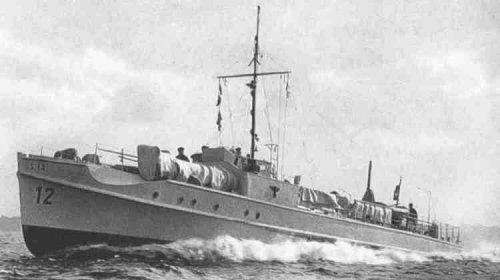 |
| Kriegsmarine Torpedo motorboat (Schnellboote) S-11. |
S-18 torpedoes and sinks British collier Joseph Swan. There is one survivor and 17 crew perish.
S-18 also torpedoes and sinks Dutch collier Nieuwland. Eight crew perish.
S-21 torpedoes and sinks 1729 ton British collier Corbrook. Everybody survives.
S-21 also torpedoes and sinks 2709 ton British collier New Lambton. Everybody survives.
S-22 torpedoes and sinks 1562 ton British cargo collier Fulham V.
S-54 damages collier Ewell.
Elsewhere, British 1945 ton ocean-going ferry Lairdcastle collides with freighter Vernon City while transiting from Glasgow to Belfast. The Lairdcastle sinks three hours later near the Mull of Kintyre, giving all 29 crew and 72 passengers time to be picked up by British destroyers.
U-47 (K.Kapt. Günther Prien) torpedoes and sinks 9035-ton British freighter Titan 250 miles northwest of Ireland. There are 89 survivors and 6 deaths. The Titan is with Convoy OA 207, and one of the escorts, HMCS St. Laurent, picks up the survivors. The master, Walter Francis Dark, later is awarded the Lloyds War Medal for bravery at sea for this action.
Prien's protege, Kptlt. Engelbert Endrass (Endrass had been Prien's second-in-command before this command), also gets a success today. His command, U-46, sinks by gunfire 1074 ton Irish freighter Luimneach, which carries pyrites, west of the Isles of Scilly around 22:00. The sinking is controversial. Apparently, Endrass surfaces and fires a shot across the bow to stop the freighter. After that, accounts diverge: the British captain, Eric Jones, claims the U-boat wrongfully continues shelling a neutral ship for no cause, while Endrass claims the crew panics and immediately abandons ship, making it a fair game as an abandoned vessel. Endrass has no torpedoes left, thus has to use the gun. There is mass confusion on both sides, and Endrass tells the men - who had crowded into one overloaded lifeboat - to go back and get a second boat. Endrass also gives them provisions. U-boat boss Admiral Doenitz, not the most impartial observer, sides with Endrass and maintains it was a good kill. Naturally, the British/Irish do not see it that way. All 18 aboard survive, and three crewmen are taken aboard the U-46, which somewhat salves the hard feelings over the event.
Royal Navy 550-ton tug HMS Saucy hits a mine and sinks in the Firth of Forth. All 26 crew perish in the massive explosion.
The first Italian submarines arrive at their new BETASOM base at Bordeaux, France.
Convoy HG 43 departs from Gibraltar, Convoy OA 209 departs from Methil, Convoy OG 42 departs from Liverpool.
U-142 is commissioned (Oberleutnant zur See Nicolai Clausen).
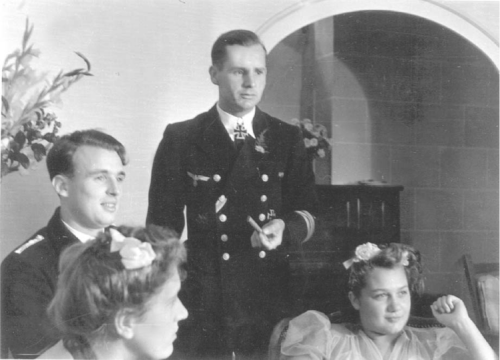 |
| Kptlt. Engelbert Endrass (standing). Endrass had been the first Watch Officer when Gunther Prien made his famous Scapa Flow attack and sank HMS Royal Oak. |
HMAS Sydney bombards Scarpanto. Battleship HMS Malaya and carrier HMS Eagle make port in Alexandria.
The RAF bombs Italian airfields near the Egyptian border. The South African Air Force raids Javcllo, Ethiopia.
At Malta, the coast is buzzed again at 21:30 by an Italian torpedo boat (MAS), but it gets away. There is an air raid alert in the late afternoon, but the bombers do not cross the coastline.
Winston Churchill is pleased with the success of Operation Hats and tells the War Cabinet that he is going to send Governor Dobbie, for distribution to the island, a letter of commendation. However, at the same time, the War Office tells Dobbie that many of the anti-aircraft guns that he has requested are needed elsewhere.
US/Japanese Relations: US Secretary of State Cordell Hull expresses concern about Japanese moves in French Indochina, where the Imperial Army has established bases at many key points.
German/Japanese Relations: The Japanese government holds meetings to decide how to approach negotiations for officially joining the Axis. The question is how to carve up the world, to create "spheres of influence" dominated by each power center, with a line drawn somewhere around India. The wishes of the Soviet Union do not appear to play a major factor.
French Indochina (Vietnam): The Japanese intercept a cable from French Army General Maurice Martin's government in French Indochina to the US and the UK which suggests that those two countries may consider intervening in French Indochina. Japan considers the country virtually its colony at this point. To protect its interests, the Japanese government considers invading rather than just maintaining bases there.
Throughout the day, King Carol still refuses to appoint Antonescu as Prime Minister despite his advisor ("courtiers") telling him that former minister Ion Antonescu is moderate and a better choice than one of the fascists from the Iron Guard who are threatening to depose the King and take over. Finally, during the evening, Valer Pop, an advisor to the King, decides to force the issue. He visits the German ambassador, Wilhelm Fabricius, to ask for Germany's support for Antonescu. Fabricius has had his doubts about Antonescu - who has been sympathetic to Germany since Munich more out of fear of German imperialism towards Romania than anything else - but abruptly throws Germany's support behind him.
Everybody, including King Carol, realizes that Germany is the only thing standing between Romania and the newly aggressive Soviet Union, so the King capitulates and agrees to appoint Antonescu. Antonescu, however, feels emboldened, and just being Prime Minister isn't enough for him: he now requests the full powers of a head of state. Carol agrees, granting Antonescu virtually all of his own powers as a monarch (making Antonescu "Conducător," somewhat similar to "Fuhrer"). Carol forces the current government led by Gigurtu to resign so that he can appoint Antonescu to form a new government. It is a remarkable rise to power for someone who had been in prison only a month before. It also is the beginning of what can best be described as a royal nightmare for Romania.
Holocaust: Chiune Sugihara, Vice-Consul for the Empire of Japan to Lithuania, is forced to leave his post in Kaunas, Lithuania when the consulate closes. Sugihara has been writing visas for thousands of Jews (exactly how many is unknown) so they can escape the gathering clouds of war and the Holocaust (many stories are circulating about atrocities in occupied Poland). Sugihara does this right up until the last moment, even throwing some off the train as it pulls out of the station. Sugihara also arranges for the Lithuanian Jews to be able to transit on the Trans-Siberian railway (for five times the usual price). Sugihara heads to Königsberg, East Prussia, where he cannot do the same thing. This "incident" is long-remembered both by the Jews he saves, as well as the Japanese government, which dismisses him for it (allegedly) in 1947. Chiune Sugihara is considered to be in the same class as Oskar Schindler and Raoul Wallenberg, though not nearly as well known.
China: Prince Nagahisa Kitashirakawa, head of a collateral branch of the Japanese Imperial Family and a career army officer, perishes in an airplane crash while on duty in Mengjiang, China.
American Homefront: R. Douglas Stuart, Jr., a Yale Law School student, organizes the America First Committee. Its mission is to keep the United States out of the war. Prominent members include Gerald Ford, Sargent Shriver and Potter Stewart (future SCOTUS Justice). The organization will find its biggest base of support around Chicago. The slogan is not new today, but the organization is.
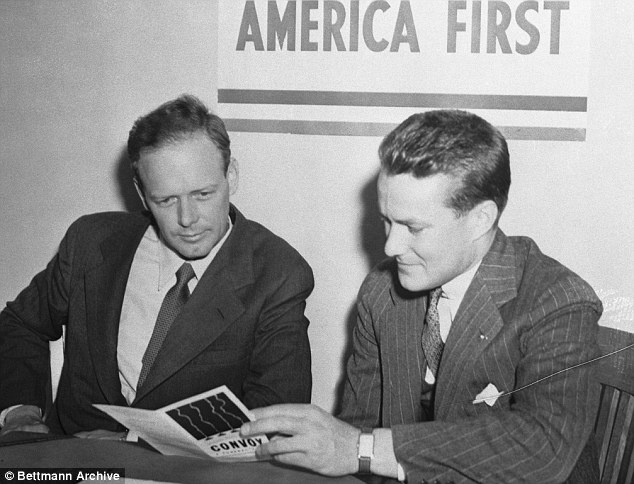 |
| Charles Lindbergh with America First founder R. Douglas Stuart, Jr. in 1940. |
September 1, 1940: RAF's Horrible Weekend
September 2, 1940: German Troopship Sunk
September 3, 1940: Destroyers for Bases
September 4, 1940: Enter Antonescu
September 5, 1940: Stukas Over Malta
September 6, 1940: The Luftwaffe Peaks
September 7, 1940: The Blitz Begins
September 8, 1940: Codeword Cromwell
September 9, 1940: Italians Attack Egypt
September 10, 1940: Hitler Postpones Sealion
September 11, 1940: British Confusion at Gibraltar
September 12, 1940: Warsaw Ghetto Approved
September 13, 1940: Zeros Attack!
September 14, 1940: The Draft Is Back
September 15, 1940: Battle of Britain Day
September 16, 1940: italians Take Sidi Barrani
September 17, 1940: Sealion Kaputt
September 18, 1940: City of Benares Incident
September 19, 1940: Disperse the Barges
September 20, 1940: A Wolfpack Gathers
September 21, 1940: Wolfpack Strikes Convoy HX-72
September 22, 1940: Vietnam War Begins
September 23, 1940: Operation Menace Begins
September 24, 1940: Dakar Fights Back
September 25, 1940: Filton Raid
September 26, 1940: Axis Time
September 27, 1940: Graveney Marsh Battle
September 28, 1940: Radio Belgique Begins
September 29, 1940: Brocklesby Collision
September 30, 1940: Operation Lena
2020






